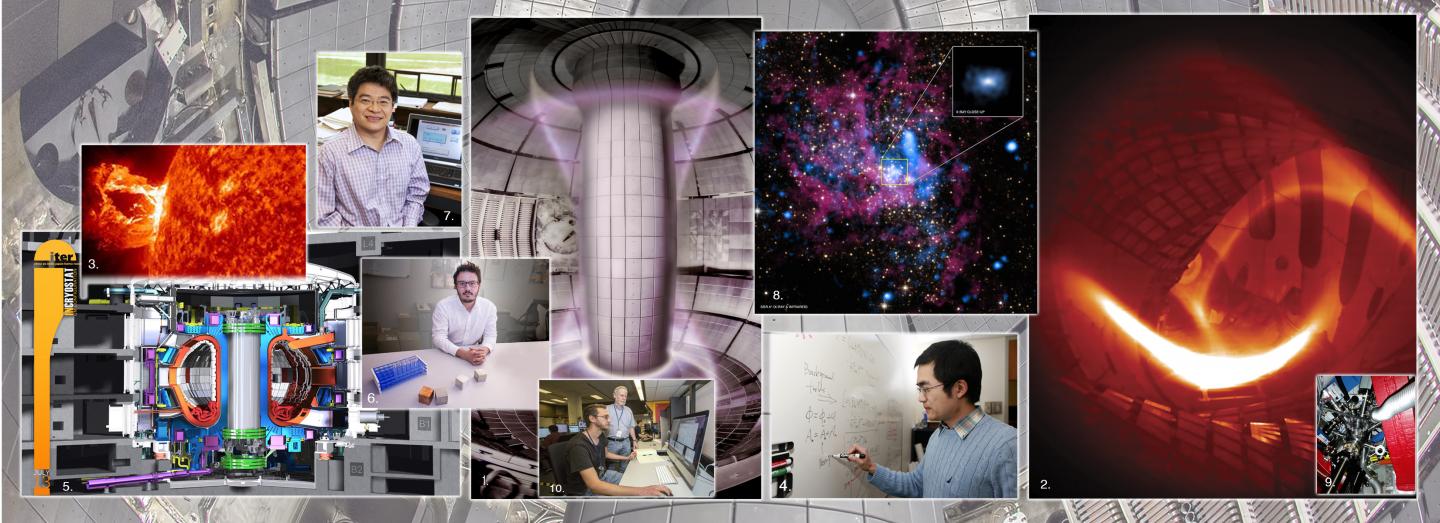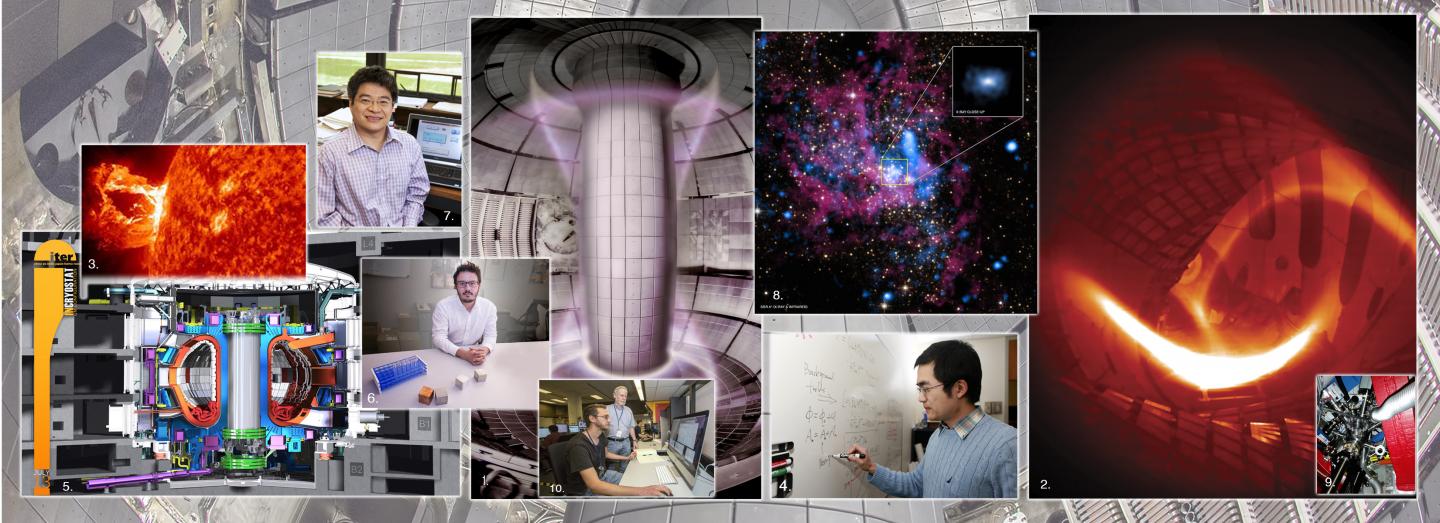
Credit: Elle Starkman/Princeton Plasma Physics Laboratory
The past year saw many firsts in experimental and theoretical research at the U.S. Department of Energy's Princeton Plasma Physics Laboratory (PPPL). Here, in no particular order, are 10 of the Laboratory's top findings in 2016, from the first results on the National Spherical Torus Experiment-Upgrade to a new use for Einstein's theory of special relativity to modeling the disk that feeds the supermassive black hole at the center of our galaxy.
1. First results of the National Spherical Torus Experiment-Upgrade (NSTX-U)
The NSTX-U recorded important findings during its first 10 weeks of operation, before shutting down for repairs. Results ranged from rapidly achieving high plasma confinement, a superior regime for plasma performance, to swiftly surpassing the maximum field strength of its predecessor prior to the upgrade. The nearly four-year overhaul doubled the heating capacity and field strength of the NSTX-U, making it the most powerful spherical torus device in the world.
2. Collaborating on fusion facilities around the world
PPPL contributes heavily to worldwide fusion experiments. PPPL leads all U.S. collaborators on the Wendelstein 7-X stellarator in Germany, and played a key role in confirming the accuracy of the twisty, 3D magnetic fields that distinguish stellarators from 2D tokamak devices. The Lab leads studies on avoiding disruptions on KSTAR, the major tokamak in South Korea, and heads a multi-institutional project to study plasma-material interaction on China's EAST tokamak. Domestically, PPPL collaborations on the DIII-D tokamak at General Atomics this year have ranged from analyzing the behavior of the crucial edge of fusion plasmas to coupling our flagship TRANSP fusion analysis code to a GA code to make TRANSP widely available to beginners and experts alike.
3. Unraveling the source of rapid reconnection
Scientists have puzzled for decades over what causes magnetic reconnection, a universal process that sets off solar flares, northern lights and geomagnetic storms, to develop so much faster than theory says it should. Recent findings at PPPL suggest the answer lies in electrically charged plasma sheets that break up into tiny magnetic islands called "plasmoids" that evolve from quiescent to explosive stages. This process, which roughly follows a principle laid out by 17th century mathematician Pierre de Fermat, accelerates magnetic reconnection, which occurs when the magnetic field lines in plasma converge and violently snap apart.
4. Applying Einstein and quantum mechanics to astrophysical mysteries
Pulsars, collapsed stars that orbit a cosmic companion and flash like lighthouses in the sky, have many properties that defy detailed explanation. Researchers at PPPL and Princeton have combined Albert Einstein's theory of special relativity with the theory of quantum mechanics to portray several of the qualities. The new method infers the strength of the magnetic field and density of the plasma that surrounds pulsars with greater precision than standard approaches can show. This method, based on the complex behavior of plasma waves, can also infer such properties for the plasma created by inertial fusion, which uses lasers to vaporize a target that contains plasma fuel.
5. Delivering power and diagnostics to ITER
The United States is a key contributor to ITER, the international fusion experiment under construction in France to demonstrate the feasibility of fusion power. PPPL is an important participant in the experiment. During the past year the Laboratory completed delivery of new major components for the steady state electrical network that will power the complex plant's electrical loads, with the exception of the pulsed loads that will power the heating, current and magnetic fields inside the giant tokamak itself. PPPL also furthered development of designs for seven diagnostic instruments that the U.S. will provide to ITER to observe, record and analyze data from its experiments.
6. First steps toward a possible technique for facilitating disarmament agreements
The Laboratory and Princeton University successfully completed a novel experiment for a system that, when fully developed, could prove useful in future disarmament talks. The experiment translated a method called "zero-knowledge protocol" that is employed in cryptography into use in a physical system. The aim of this system is to determine, without tapping into classified information, whether objects to be dismantled are true nuclear warheads. The experiment successfully distinguished between "true" and "false" patterns of 2-inch steel and aluminum cubes without revealing any information about the composition and configuration of the cubes. While far more development will need to be done, the test marked a promising beginning.
7. Creating a framework for improving high-intensity particle accelerator beams
Accelerator beams consist of billions of charged particles that are used in scientific experiments to strike other particles with enormous intensity and generate subatomic particles not seen since the early universe. However, mutual repulsion of the particles and imperfections of accelerators tend to degrade the beam, so the walls of large devices are lined with high-precision magnets to control the motion. Now researchers at PPPL, South Korea and Germany have teamed up to develop a theoretical framework for optimizing the beams. The new method contrasts with standard approaches, which treat the horizontal and vertical motions of the charged particles as uncoupled. Instead, the new system couples all forces and elements that can stabilize the beam, and the results agreed well with simulation of a German experiment that illustrated a technique for manipulating the beams of future accelerators.
8. Modeling the accretion disk that feeds the black hole at the center of our galaxy
As the accretion disk that orbits the supermassive black hole at the center of the Milky Way spirals into the hole, the plasma particles that comprise it emit far less radiation than the disks that flow into many other black holes. The question is why, since feeding black holes can create some of the brightest and most energetic radiation in the universe, and the huge Milky Way hole has four million times the mass of our sun. To help find the answer, scientists at PPPL and Princeton University have developed a rigorous new method for modeling the disk around the gigantic Milky Way hole, which is called Sagittarius A*. The particles inside this disk's plasma rarely collide, compared with the frequent collisions of particles in other disks. So tracing the movements of individual collisionless particles in Sagittarius A*, rather than relying on standard formulas that treat the plasma in collisional disks as a fluid, could produce improved predictions of how the Sagittarius A* disk will behave when compared with astrophysical observations.
9. A shot-by-shot look at what happens when plasma meets walls
Of crucial importance to the production of fusion energy is the contact during experiments — or shots — between particles of the hot plasma that fuels fusion reactions and the walls that enclose the magnetically confined gas. Such contact can erode the walls of a fusion facility and recycle the particles back into the core of the plasma, cooling it down and halting fusion reactions. At PPPL, physicists have collaborated with a consortium that includes Princeton University and the University of Illinois at Urbana-Champaign to successfully test a unique diagnostic called a Materials Analysis Particle Probe (MAPP) that swiftly analyzes what happens when plasma meets a tokamak's walls. The diagnostic, tested on a shot-by-shot basis on the NSTX-U at PPPL, could become an integral part of fusion research and lead to optimal methods of conditioning a facility's walls.
10. Gauging the speed of fusion plasma rotation
The superhot plasma that fuels fusion reactions swirls rapidly during experiments — but how fast is it spinning and why do researchers want to know? At PPPL, physicists have developed a real time velocity diagnostic that delivers crucial information about the speed of the swirl that could lead to a system for actively controlling the rapid motion. Such control can be critical for optimizing the stability of the plasma against a range of instabilities that can shut down reactions. Researchers gathered their findings by measuring just four points of the plasma during NSTX-U operations, enabling the diagnostic to swiftly calculate how the velocity evolves over time.
###
PPPL, on Princeton University's Forrestal Campus in Plainsboro, N.J., is devoted to creating new knowledge about the physics of plasmas — ultra-hot, charged gases — and to developing practical solutions for the creation of fusion energy. The Laboratory is managed by the University for the U.S. Department of Energy's Office of Science, which is the largest single supporter of basic research in the physical sciences in the United States, and is working to address some of the most pressing challenges of our time. For more information, please visit science.energy.gov.
Media Contact
John Greenwald
[email protected]
609-243-2672
@PPPLab
http://www.pppl.gov
############
Story Source: Materials provided by Scienmag





